British Rail Class 47
|
Two Class 47s, Nos. 47424 and 47607, at Bangor station with a passenger train in 1987 | |||||||||||||||||||||||||||||||||
| |||||||||||||||||||||||||||||||||
| |||||||||||||||||||||||||||||||||
| |||||||||||||||||||||||||||||||||
| |||||||||||||||||||||||||||||||||
The British Rail Class 47 is a class of British railway diesel-electric locomotive that was developed in the 1960s by Brush Traction. A total of 512 Class 47s were built at Crewe Works and Brush's Falcon Works, Loughborough between 1962 and 1968, which made them the most numerous class of British mainline diesel locomotive.
They were fitted with the Sulzer 12LDA28C twin-bank twelve-cylinder unit producing 2,750 bhp (2,050 kW) - though this was later derated to 2,580 bhp (1,920 kW) to improve reliability - and have been used on both passenger and freight trains on Britain's railways for over 50 years. Despite the introduction of more modern types of traction, a significant number are still in use, both on the mainline and on heritage railways. As of October 2016, 81 locomotives still exist as Class 47s, with further examples having been converted to other classes; 30 retain "operational status" on the mainline.
Origins
The Class 47 history begins in the early 1960s with the stated aim of the British Transport Commission (BTC) to completely remove steam locomotives from British Rail by a target date of 1968.[1] They therefore required a large build of lightweight Type 4 locomotives to achieve this aim. This required locomotives producing at least 2,500 bhp (1,900 kW) but with an axle load of no more than 19 long tons (19 t). However, the BTC were not convinced that the future of diesel traction lay down the hydraulic transmission path of the Western Region, and began looking at various diesel-electric designs.
Despite the construction of two demonstration locomotives (D0260 LION, produced by AEI and BRC&W using a Sulzer engine,[2] and D0280 FALCON, built by Brush Traction using Maybach engines),[3] the need for a large number of locomotives quickly was deemed paramount, and the pilot build of what would become Class 47 began before the prototypes could be comprehensively assessed.[4] This initial build of 20 locomotives (Nos. D1500 to D1519) were mechanically different from the remainder of the type,[5] and would be withdrawn earlier. However, based on these and the success of LION, an order for 270 locomotives was made, which was later revised upwards a number of times to reach the final total of 512. Five locomotives, Nos. D1702 to D1706, were fitted with a Sulzer V12 12LVA24 power unit and classified as Class 48s; the experiment was not deemed a success, and they were later converted to standard 47s.
In service
Eventually, 310 locomotives were constructed by Brush in Loughborough, and the remaining 202 at BR's Crewe Works.[6] The first 500 locomotives were numbered sequentially from D1500 to D1999, with the remaining twelve being numbered from D1100 to D1111. The locomotives went to work on passenger and freight duties on all regions of British Rail. Large numbers went to replace steam locomotives, especially on express passenger duties.[7]
The locomotives, bar a batch of 81 built for freight duties, were all fitted with steam heating boilers for train heat duties. The initial batch of twenty, plus D1960 and D1961, were also fitted with electric train heating (ETH).[8] With this type of heating becoming standard, a further large number of locomotives were later fitted with this equipment.
In the mid 1960s, it was decided to de-rate the engine output of the fleet from 2,750 bhp (2,050 kW) to 2,580 bhp (1,920 kW).[9] This significantly improved reliability by reducing stresses on the power plant, whilst not causing a noticeable reduction in performance.[10]
Sub-Classes
In the early 1970s, the fleet was renumbered into the 47xxx series to conform with the computerised TOPS systems. This enabled a number of easily recognisable sub-classes to be created, depending on the differing equipment fitted. The original series were based on train heating capability and were as follows;[11]
- Class 47/0: Locomotives with steam heating equipment.[12]
- Class 47/3: Locomotives with no train heating.[12]
- Class 47/4: Locomotives with dual or electric train heating.[12]
However, this numbering system was later disrupted as locomotives were fitted with extra equipment and were renumbered into other sub-classes.[13][14] For an overview of the renumbering see the Class 47 renumbering page. This section summarises the main sub-classes that were created.
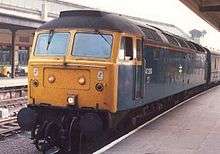
Class 47/0
Originally numbered from 47001 to 47298, these locomotives were the "basic" Class 47 with steam heating equipment fitted.[15] In the 1970s and 1980s, with steam heating of trains gradually being phased out, all locomotives fitted with the equipment gradually had their steam heating boilers removed. Some were fitted with ETH and became 47/4s, whilst the others remained with no train heating capability and were therefore used mainly on freight work. In the 1990s, the class designation 47/2 was applied to some class 47/0s and class 47/3s after they were fitted with multiple working equipment.[10] The locomotives involved also had their vacuum braking systems removed or isolated, leaving them air braked only. This was mainly a paper exercise, however, and the locomotives were not renumbered; in this article they are included in Class 47/0.
Class 47/3
Originally numbered from 47301 to 47381, this sub-class was originally built with no train heating equipment and therefore remained as freight locomotives almost exclusively for their working lives.[16] They were all fitted with slow speed control for working MGR coal trains (as were a number of Class 47/0s).[17] However, during the summer months when train heat was not required, 47/3s could regularly be found hauling the extra trains that the holiday season brought.[18] The sub-type remained stable until withdrawals started, although an "extra" 47/3, No.47300, was created in 1992 when No.47468 had its train heating equipment removed and was renumbered.[19] This was a direct replacement for collision damaged 47343. Also, No.47364 was renumbered to 47981 in 1993 for use on RTC test trains.[20]
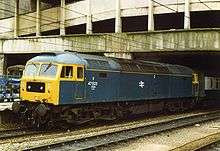
Class 47/4
The designation for standard locomotives fitted with ETH and therefore used for passenger, mail and parcels use. 133 locomotives had been fitted by the time renumbering occurred, and shortly afterwards the sub-class had settled down to 154 locomotives, numbered 47401-47547 and 47549-47555. Later, further class 47/0s were converted to class 47/4s and renumbered into the series from 47556 onwards, which eventually reached 47665.[21]
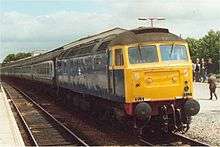
Class 47/6 and Class 47/9
After being severely damaged in a derailment near Peterborough in 1974, locomotive 47046 was selected to be a testbed for the projected Class 56, and was fitted with a 16-cylinder Ruston 16RK3CT engine rated at 3,250 bhp (2,420 kW) for assessment purposes.[22] To identify it as unique, it was renumbered 47601 (at the time the number range for Class 47s only extended as far as 47555). Later, in 1979, it was used again for the Class 58 project, fitted with a 12-cylinder Ruston engine (this time of 3,300 bhp (2,500 kW)), and renumbered 47901. It continued with this non-standard engine fitted until its withdrawal in 1990.[23]
.jpg)
Class 47/7
In the late 1970s, BR authorities identified a need to replace the ageing trains operating the Glasgow to Edinburgh shuttle services, in order to increase speed and reliability. The trains were operated by pairs of Class 27s, one at each end of this train. It was decided to convert twelve 47/4s to operate the service in push-pull mode. The locomotives would be known as Class 47/7 and would be fitted with TDM push-pull equipment[24] and long-range fuel tanks, and be maintained to operate at 100 mph (160 km/h). The conversions began in 1979 and the service was operated completely by them from 1980. In 1985, the push-pull service spread to Glasgow-Aberdeen services, and a further four locomotives were converted. The sub-class therefore comprised Nos. 47701 to 47716, though a further locomotive, 47717, was converted in 1988 after the fire-damaged 47713 was withdrawn.[25]

Class 47/7b and 47/7c
In the 1990s, further 47/4s were converted with long-range fuel tanks and equipment to allow them to work with a type of rolling stock known as propelling control vehicles-PCV, which utilised RCH (Railway Clearing House) cables to allow the PCV driver to signal to the driver on the locomotive to apply power and operate the brakes - neither these locomotives or the PCVs were equipped with TDM push-pull equipment. They were also numbered into the 47/7 series, from 47721 onwards. With dwindling passenger work for them, a number of 47/8s, already fitted with the extra fuel tanks, were also renumbered into this series.[26]
Two locomotives, 47798 Prince William and 47799 Prince Henry, were dedicated for use on the Royal Train, and were designated as Class 47/7c.[27]

Class 47/8
The last of the original 47/4 conversions, from 47650 to 47665, were fitted with extra fuel tanks, giving them an extended range. Four earlier Class 47/4s were also converted. In 1989 it was decided to give these locomotives easy recognisability, and so these locomotives were renumbered into their own series from 47801 to 47820. At the same time, further locomotives were fitted with extra fuel tanks and renumbered; the series eventually reached 47854.[28] After the privatisation of British Rail, the locomotives in the 47/8 number range were mainly used by Virgin Trains on cross-country work until the introduction of their Voyager trains. These duties have kept them maintained in serviceable condition, allowing them to remain operational longer than the majority of their classmates. As a consequence most of them received relatively recent overhauls. The locomotives in this number range are officially Class 47/4s under the TOPS system.
Decline
By 1986, only five of the original 512 locomotives had been withdrawn from service, all because of serious accident damage.[28] However, with work for the class declining due to the introduction of new rolling stock, and spare parts becoming difficult to source, some inroads started being made.
The first locomotives to be targeted were the non-standard pilot batch of 20, now numbered 47401-47420. Three locomotives were withdrawn as life-expired in February 1986, and the remainder of the batch that had not recently been overhauled followed in the next two years. All 20 were withdrawn by 1992.[29]
Meanwhile, BR drew up a 'hit-list' of locomotives for early withdrawal, mainly including those with non-standard electrical equipment, known as series parallel locomotives.[30] In the outset, withdrawals were slow, mainly due to the surplus of spare parts and new flows of freight traffic which required extra locomotives; only 61 locomotives had been withdrawn by the end of 1992. However, with the introduction of new locomotives, the rate of withdrawal quickly rose, with 86 more 47s reaching the end of their lives in the next three years.[28] With most of the non-standard locomotives withdrawn, the reduction of the fleet again proceeded more slowly. The privatisation of British Rail also produced new independent rail companies needing available traction until they could order new locomotives. From 1996 to 2006, an average of around fifteen locomotives per year were taken out of service.[28]
During the decline in passenger work a number of locomotives were painted in "celebrity" colours, depicting various liveries that the type had carried during its history. This continued a tradition of painting 47s in unusual liveries, which dates back to 1977, when Stratford depot in East London painted two locomotives with huge Union Flags to celebrate the Silver Jubilee of Queen Elizabeth II.[31]
Current mainline operation
In October 2016, after over 54 years of front line passenger and freight operations, 30 locomotives retain operational status on the National network.[32] The following is a list of companies currently operating Class 47s.
- West Coast Railway Company is primarily a charter train operator, and expanded its fleet by overhauling withdrawn locomotives. Its ten locomotives currently operational are 47237, 47245, 47746, 47760, 47786, 47802, 47804, 47826, 47851 and 47854.
- Direct Rail Services (DRS) locomotives appear on freight, stock movements, charter trains and spot-hire duties. Locomotives currently operational are 47790, 47805, 47810, 47813, 47818, 47832, 47841 and 47853.
- Riviera Trains is a company based at Crewe with a fleet of locomotives which are mainly used to haul charter trains, but have since been hired out for use with GBRf, maintained by HNRC. Locomotives currently operational are 47812, 47815, 47843 and 47848.
- Colas Rail owns a small fleet of locomotives for duties hauling its track maintenance trains and occasional steel traffic. Locomotives currently operational are 47375, 47727, 47739 and 47749.
- Freightliner Group, a freight company, operate 47830 (D1645), which was named Beeching's Legacy on 12 November 2015 to mark 50 years since the first container train ran under British Rail. The naming ceremony was held at the National Railway Museum at York, with the Secretary of State for Transport, Patrick McLoughlin in attendance.[33]
- A number of other locomotives are stored in a serviceable condition by these and other operators (currently, 47501, 47701 and 47847 fall into this category). Both these and some preserved locomotives that are maintained to mainline standards (such as "Royal Train" locomotive 47798, along with 47270, 47580 and 47773) may appear on the network at any time.
- 19 further locomotives, owned by various companies, remain in non-operational "stored" condition. As of October 2016 these are 47194, 47236, 47355, 47368, 47488, 47492, 47500, 47526, 47703, 47714, 47744, 47761, 47768, 47769, 47772, 47776, 47787, 47811 and 47816. Some are used for spares, some are awaiting scrapping and the rest are pending repairs to enable them to return to the main line.
Other working locomotives
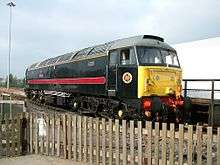
Class 47s have proved very popular with preservationists and private railways, and 32 are currently in preservation, with the majority in working order.[34] A full list can be found at list of preserved British Rail Class 47 locomotives.
Thirty-three locomotives were rebuilt with EMD engines and re-classified as Class 57s.[35][36] Freightliner took 12, Virgin Trains 16 and First Great Western five. Today these are owned by Direct Rail Services (22), Great Western Railway (four) and West Coast Railway Company (eight, including the prototype passenger class 57, 57601).
Accidents and incidents
- 11 January 1965: D1734 was severely damaged after the freight train it was hauling ran out of control near Shrewsbury, eventually demolishing a signal box. It was withdrawn two months later, becoming the first Class 47 withdrawn after a working life of only eight months.[37]
- 17 December 1965: D1671 THOR was derailed near Bridgend whilst hauling a train of empty coaches.[38] Shortly afterwards, a freight train collided heavily with the wreckage, killing the drivers of both locomotives. D1671 was withdrawn some four months later. Its nameplates were salvaged, and transferred to No. D1677.[39]
- 8 April 1969: D1908 was badly damaged when, while hauling a freight train at Monmore Green, it was struck head-on by a passenger train that had passed a signal at danger. D1908 caught fire after the accident and became the third Class 47 withdrawn.[40]
- 13 March 1971: D1562 was wrecked after its power unit, which had been experimentally uprated, exploded at Haughley Junction while the locomotive was hauling a Liverpool Street to Norwich express.[41]
- 11 June 1972: D1630 was involved in the Eltham Well Hall rail crash in which six people were killed. The locomotive was repaired, but much later in its life when numbered 47849, it was withdrawn from the Class 57 rebuilding programme after damage was discovered which was thought to have dated back to the accident.[42]
- 16 March 1976: 47274 collided with a lorry that had fallen from a bridge onto the line near Eastriggs. The drivers of both the train and the lorry were killed.[43]
- 5 September 1977: 47402 was hauling a mail train when it was in a head-on collision with a diesel multiple unit at Farnley Junction, Leeds, West Yorkshire due to a signalling fault. Two people were killed and fifteen were injured.[44]
- 22 October 1979: 47208 became the fifth Class 47 to be withdrawn after suffering severe damage in a fatal accident at Invergowrie in Scotland. 47208 was hauling a Glasgow to Aberdeen service which collided with a local train which had stopped in front.[45]
- 9 December 1983: 47299 (formerly 47216) was involved in a serious accident at Wrawby Junction in Lincolnshire, when whilst hauling an oil train, the locomotive collided with a local train resulting in the death of a passenger. It later emerged that the locomotive's renumbering was allegedly due to a warning given to BR by a clairvoyant who claimed to have foreseen a serious accident involving a locomotive numbered 47216.[46]
- 30 July 1984: 47707 Holyrood was propelling the 17:30 express from Edinburgh to Glasgow from the rear, when the train collided with a cow near Polmont and was derailed, resulting in 13 deaths. The accident raised serious concerns about the safety of push-pull operation where the locomotive was at the rear of the train.[47]
- 20 December 1984: Summit Tunnel fire: Locomotive 47125 was hauling a freight train of petrol tankers which derailed and caught fire in Summit Tunnel, on the Lancashire/West Yorkshire border.
- 9 March 1986: Locomotive No. 47334 was one of two light engines that were hit head-on by a passenger train at Chinley, Derbyshire due to a signalman's error. One person was killed. Lack of training and a power cut were contributory factors.[48]
- 20 February 1987: 47089 Amazon was hauling a freight train that ran away and was derailed by trap points at North Junction, Chinley, Derbyshire. Another train ran into the wreckage and was derailed.[49]
- 24 March 1987: 47202 was hauling a freight train that overran signals and was in a head-on collision with a passenger train (hauled by 33032) at Frome North Junction, Somerset. Several people were seriously injured.[50]
Gallery of liveries
- Class 47/4 No.47851 in a "heritage" livery of the original BR two-tone green with full yellow cabs
- Class 47/3 No. 47316 'Cam Peak', carrying the livery of Cotswold Rail
- Class 47/7a No.47714 in Anglia livery
 Class 47/0 No.47100 in the modified Rail Blue livery with a silver roof, used by Stratford TMD
Class 47/0 No.47100 in the modified Rail Blue livery with a silver roof, used by Stratford TMD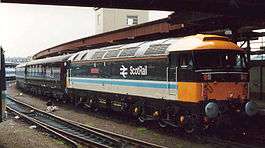 Class 47/7a No.47702 in ScotRail livery
Class 47/7a No.47702 in ScotRail livery Class 47/4 No.47588 in "triple-grey" Railfreight Distribution livery
Class 47/4 No.47588 in "triple-grey" Railfreight Distribution livery Class 47/4 No.47487 in original InterCity livery
Class 47/4 No.47487 in original InterCity livery- Class 47/4 No. 47818, in 'one' livery at Cambridge station in 2004
- Class 47/0 No. 47237, in Advenza Freight livery and Class 57 No. 57005 in Freightliner livery at Derby railway station in 2008
- Class 47/0 No. 47145 in Railfreight Distribution non-standard blue livery operated by Fragonset Railways at this time. This loco has now been scrapped.
- Class 47/0 No. 47292 in a non-standard variation of BR Rail Blue at the Great Central Railway (preserved) in July 2010
Cuba
Between 1963 and 1966 ten locomotives similar to the British Rail Class 47 were supplied to Ferrocarriles de Cuba (Cuban National Railways).[51]
See also
References and sources
References
- ↑ The railways archive - Retrieved on 2007-06-15
- ↑ Feature on D0260 LION Class47.com - Retrieved on 2007-05-31
- ↑ Feature on D0280 FALCON Class47.com - Retrieved on 2007-05-31
- ↑ Introduction to Prototypes Class47.com Retrieved on 2007-05-31
- ↑ Class 47 history Gloucester Transport History - Retrieved on 2007-06-04
- ↑ Class 47 History SEMG - Retrieved on 2007-06-01
- ↑ Class 47 History Archived June 14, 2007, at the Wayback Machine. GSWR - Retrieved on 2007-06-04
- ↑ Early diesel locomotives SEMG - Retrieved on 2007-06-01
- ↑ Class 47 history Felgall.com - Retrieved on 2007-06-01
- 1 2 Locomotive modifications The Railway Centre - Retrieved on 2007-06-04
- ↑ Class 47 numbering The Railway Centre - Retrieved on 2007-05-31
- 1 2 3 Toms 1978, pp. 66–67
- ↑ Class 47 sub-classes The Junction - Retrieved on 2007-06-04
- ↑ Class47.com numbering Retrieved on 2007-06-14
- ↑ Class 47/0 Class47.com -Retrieved on 2007-06-15
- ↑ Class 47/3 Class47.com -Retrieved on 2007-06-15
- ↑ Slow speed control Archived July 24, 2008, at the Wayback Machine. Class 58 Loco Group - Retrieved on 2007-06-15
- ↑ Lund, E (1980). To the last drop. Chesterfield: Longden technical Publications. ISBN 0-9507063-0-2.
- ↑ No.47300 Archived January 8, 2009, at the Wayback Machine. Class47.com -Retrieved on 2007-06-15
- ↑ No.47981 Archived January 8, 2009, at the Wayback Machine. Class47.com -Retrieved on 2007-06-15
- ↑ Class 47/4 Class47.com - Retrieved on 2007-06-15
- ↑ Williams, Alan; Percival, David (1977). British Railways Locomotives and Multiple Units including Preserved Locomotives 1977 Combined Volume. Shepperton: Ian Allan Ltd. ISBN 0-7110-0751-9.
- ↑ Class 47/6 Class47.com - Retrieved on 2007-06-15
- ↑ "TDM/RCH specification" (PDF). Mechanical And Electrical Coupling Index. RSSB.
- ↑ Class 47/7 Felgall Rail - Retrieved on 2007-06-15
- ↑ Class 47/7 Class47.com - Retrieved on 2007-06-15
- ↑ Locomotive pools Class47.com Retrieved on 2007-07-09
- 1 2 3 4 Class 47 withdrawal data Class47.com - Retrieved on 2007-06-04
- ↑ 47401 History The 47401 Project - Retrieved on 2007-06-10
- ↑ Class 47 Technical Details Railfan page - Retrieved on 2007-06-04
- ↑ Silver Jubilee livery Archived January 8, 2009, at the Wayback Machine. Brushtype4.co.uk, retrieved on 2008-04-30
- ↑ "Fleet status, October 2016". Retrieved 30 October 2016.
- ↑ "Freightliner marks 50 years with a naming". The Railway Magazine. Vol. 161 no. 1,377. Horncastle, Lincs: Mortons Media Group. 2 December 2015. p. 7. ISSN 0033-8923.
- ↑ Class 47 Page Preserved Diesels - Retrieved on 2007-04-30
- ↑ Class 57 page The Junction - Retrieved on 2007-04-30
- ↑ Class 57 conversion The Railway Centre - Retrieved on 2007-04-30
- ↑ locomotive D1734 Class47.com - Retrieved on 2007-07-08
- ↑ Toms 1978, p. 69
- ↑ locomotive D1671 Class47.com - Retrieved on 2007-07-10
- ↑ locomotive D1908 Class47.com - Retrieved on 2007-07-10
- ↑ - Retrieved on 2014-30-11
- ↑ locomotive D1630 Class47.com - Retrieved on 2007-05-14
- ↑ Railwaysarchive.co.uk - Retrieved on 2015-11-05
- ↑ Trevena, Arthur (1981). Trains in Trouble: Vol. 2. Redruth: Atlantic Books. p. 47. ISBN 0-906899-03-6.
- ↑ Invergowrie accident report Railwaysarchive.co.uk - Retrieved on 2007-04-30
- ↑ Jinxed locomotive 47299 Railfan article - Retrieved on 2007-04-30
- ↑ The Polmont accident in the light of 2001 Selby Crash Danger Ahead - Retrieved on 2007-04-30
- ↑ Vaughan, Adrian (1989). Obstruction Danger. Wellingborough: Patrick Stephens Limited. pp. 240–48. ISBN 1-85260-055-1.
- ↑ Earnshaw, Alan (1991). Trains in Trouble: Vol. 7. Penryn: Atlantic Books. p. 45. ISBN 0-906899-50-8.
- ↑ Vaughan, Adrian (2003) [2000]. Tracks to Disaster. Hersham: Ian Allan. pp. 10–11. ISBN 0 7110 2985 7.
- ↑ Thunderbuck Ram (1965-07-30). "Cuba". Class47.co.uk. Retrieved 2012-08-15.
Sources
- Stevens-Stratten, S.W.; Carter, R.S. (1978). British Rail Main-Line Diesels. Shepperton: Ian Allan Ltd. ISBN 0-7110-0617-2.
- Toms, George (1978). Brush Diesel Locomotives, 1940-78. Sheffield: Turntable Publications. ISBN 0902844482. OCLC 11213057.
Further reading
- Derrick, Kevin (2013). Looking back at Class 47 Locomotives. Strathwood. ISBN 9781905276233.
- Lilley, Simon (2012). Class 47: 50 Years of Locomotive History. OPC. ISBN 9780860936480. OCLC 794815314.
- Loader, Martin (1998). Class 47 Photo File. Vanguard Publications. ISBN 9781900872041. OCLC 650096345.
- McManus, Michael. Ultimate Allocations, British Railways Locomotives 1948 - 1968. Wirral. Michael McManus.
- Meskell, Nick (2006). Class 47/8s. Train Crazy Publishing. ISBN 9780954803551. OCLC 190776405.
- Morrison, Brian (1987). Profile of the 47s. OPC. ISBN 9780860932406. OCLC 16924495.
- Morrison, Gavin (2011). BR Brush Class 47: 48 Years of Different Livieries. Book Law Publications. ISBN 9781907094668. OCLC 751709977.
- Morrison, Gavin (1999). Class 47s. Ian Allan. ISBN 9780711026773. OCLC 41503765.
- Ringer, Brian (1979). Brush-Sulzer Class 47 Diesel-Electrics. Bradford Barton. ISBN 9780851533261. OCLC 16431685.
- Tayler, A.T.H.; Thorley, W.G.F.; Hill, T.J. (1979). Class 47 Diesels. Ian Allan. ISBN 9780711009158. OCLC 6425727.
- Taylor, Ross (2016). Class 47 and 57 Locomotives. Amberley Publishing. ISBN 9781445658636. OCLC 934603465.
- Vaughan, John (2007). Diesel Retrospective: Class 47. Ian Allan. ISBN 9780711032019. OCLC 163322802.
- British Rail Class 47s. Peter Watts. 1980. ISBN 9780906025130. OCLC 655703332.
- Kerr, Fred (August 1983). "Big Brushes that swept clean!". Rail Enthusiast. EMAP National Publications. pp. 34–39. ISSN 0262-561X. OCLC 49957965.
- Kerr, Fred (October 1983). "The big Brushes - part two". Rail Enthusiast. EMAP National Publications. pp. 10–14. ISSN 0262-561X. OCLC 49957965.
External links
| Wikimedia Commons has media related to British Rail Class 47. |
